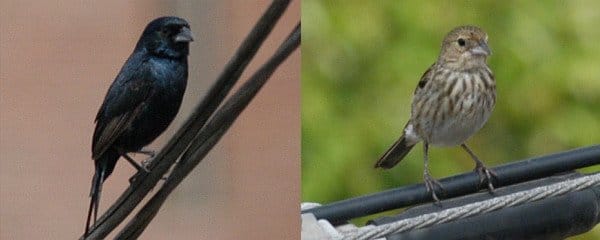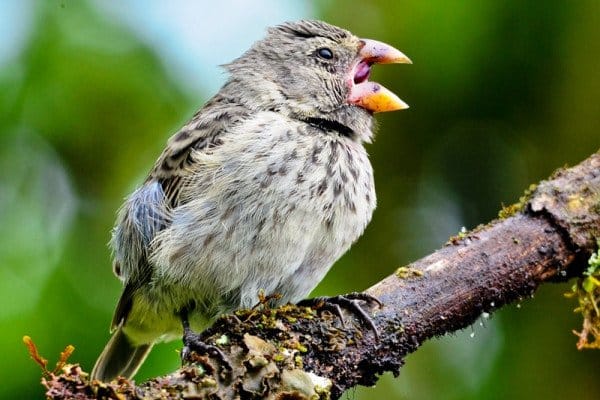The word “tanager” conjures certain images for most of us birder types. Maybe words like “colorful,” “beautiful,” “fruit,” and “tree.” But the tanager brand is changing. We’re learning we’ve got to expand our idea of what it means to be a tanager.
Double-collared Seedeater (Sporophila caerulescens) © Dario Sanches
These sparrows are tanagers
A new proposal to the American Ornithologists’ Union South American Classification Committee would transfer a whopping 33 Neotropical genera, many formerly placed in the New World sparrow and bunting family Emberizidae, to the tanager family, Thraupidae. Most of these birds are small, finch-like species with thick, conical bills for cracking seeds or eating insects.
They include the seedeaters; the grassquits and other “quits”; the yellow-finches, warbling-finches, and mountain-finches; and the wonderful assemblage of Galápagos finches (“Darwin’s finches”)!

Male and female Blue-black Grassquits (Volatinia jacarina) in Peru © David J. Ringer
“For a decade or more, we’ve known from genetic data that many primarily South American genera placed traditionally in the Emberizidae are actually tanagers,” the proposal says, citing 16 different molecular and morphological studies to support the transfers.
Indeed, some readers may recall that back in 2009, when the AOU shifted Piranga tanagers (including familiar North American summer-resident Scarlet, Summer, and Western Tanagers) to the cardinal-grosbeak family, I blogged: “[T]here is one species that breeds regularly in the ABA area and will, when the taxonomic dust settles, belong in the Thraupidae … the White-collared Seedeater.”
Bill shape and systematics
For a long time, the colorful, diverse, and species-rich group of primarily New World birds called nine-primaried oscines (about 10 percent of all living bird species) were classified largely by the shapes and sizes of their bills. Writing in the Journal of Avian Biology in 2003, Van Remsen theorized:
[T]he bill may exert more influence on our cognitive perception because of its proximity to the bird’s face. The close association of bill size and shape with food type and feeding behavior adds additional weight to the ornithologist’s perception of their “importance.” For these reasons, it is perhaps no surprise that bird bills have played a prominent role in their classification.
He goes on to describe how early classifications of the nine-primaried oscines relied on bill shape to determine family boundaries. (PDF: The “Coerebidae”: a polyphyletic taxon that dramatizes historical over-emphasis on bill shape as a taxonomic character)

Ground-finch (Geospiza sp.) on the Galápagos © Donna Lynn Schulman
Birds’ bills can be extremely adaptable to allow birds to exploit new food sources, shifting and changing so rapidly that they are actually make a terrible measure of relatedness in many cases.
A wonderful Audubon magazine article on birds’ bills (“Pecking Order“) notes that individual Great Tits in England experience a change in bill shape between summer and winter as their primary food sources shift. And Eurasian Oystercatchers can change their bill shape in about two weeks if they need to adapt to a new type of food.
Within populations of birds, selection can operate very quickly — over a couple of generations in some well-studied cases — to change the average bill size and shape when new opportunities emerge or changes in food supply demand a change.
A new perspective on tanagers
Much of the core of the tanager family remains intact. The outrageous and dazzling tanagers of Neotropical forests are, for the most part, still decidedly tanagers.
But joining them now as our understanding grows are a host of small, often plain-colored seed-eating skulkers of high alpine grasslands and dense tropical reedbeds and grasslands. Odd little grassquits singing from power lines in South America’s great cities. Iconic and amazing Galápagos finches, some of which even learned how to use tools. These are neither sparrows, nor finches, but tanagers.
The spectacularly billed honeycreepers and flowerpiercers are tanagers too, it seems, rounding out a family that displays an astonishing, dizzying, endlessly fascinating range of bill shapes, sizes, and functions.
I think it’s inevitable that the proposal will pass the SACC and that the North American list will follow. John Boyd gives us an idea of how the new Thraupidae is shaping up. Much more work remains to be done, but as I often say, it’s an exciting time to be a birder — and it’s an exciting time to be high on tanagers.














Good thing I just started this bird thing. I don’t have much to unlearn. Boom & Gary of the Vermilon River, Canada.
Give it a week or two Gary, and you’ll have to start again.
Interesting stuff, David. Makes you wonder which group will fall next.